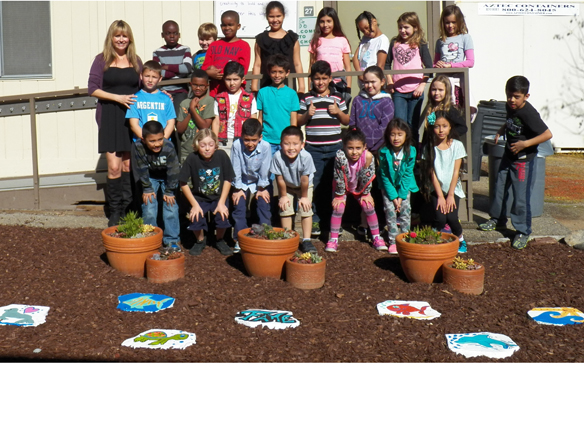Shauna Stueve lives in the Ocean Beach community of San Diego. She cares so deeply about keeping coastal areas clean and protected that she volunteers with the Surfrider Foundation. In El Cajon, she is known as “Ms. Stueve” to the 23 third-graders she teaches at Flying Hills Elementary School. For the second year in a row, helped by a small grant, she has brought together her passion and her profession for a series of special class projects designed to increase her students’ environmental awareness.
Shauna Stueve lives in the Ocean Beach community of San Diego. She cares so deeply about keeping coastal areas clean and protected that she volunteers with the Surfrider Foundation. In El Cajon, she is known as “Ms. Stueve” to the 23 third-graders she teaches at Flying Hills Elementary School. For the second year in a row, helped by a small grant, she has brought together her passion and her profession for a series of special class projects designed to increase her students’ environmental awareness.
Stueve arrived two years ago at Flying Hills Elementary School to teach third grade. She was dismayed upon discovering that even such simple environmental-care interventions as recycling bins and easy-use trashcans were unavailable at Flying Hills, because of budget constraints. The physical environment at the school was lackluster and often littered.
A random 2013 e-mail from The San Diego Foundation caught Stueve’s attention, for announcing a grant program of the San Diego Teacher’s Fund especially targeted toward classroom lessons that would spill over into student engagement for community betterment and service projects. The opportunity led Stueve to apply, and her application was awarded $1,000 for the 2013-2014 school year for student-participation campus beautification efforts, including paint, stepping stones and planters, and a one-day beach cleanup field trip for her class. The grant also paid for recycling bins scattered around the Flying Hills’ campus classrooms and trash pick-up tools.
This year, Stueve wondered whether she would even be considered to receive a second similar grant. She applied again, was awarded the money, and her 8- and 9-year-old students are happy to be continuing their year-older schoolmates’ missions of protecting the ocean, cleaning the beaches and making their school grounds cleaner, safer and more beautiful.
The projects made possible with the new grant are already having positive school-grounds effects, building on last year’s foundation. New sets of stepping-stones, hand-decorated with ocean, nature and art themes like those from a year earlier, adorn a new spot on campus. More containers holding native plants rest amid wood-chipped garden cutouts along walkways. A freshly painted original mural enlivens the quadrangle wall outside the school restrooms.
“Everyone’s been extremely supportive,” Stueve said.
She said in particular the assistance and enthusiasm of the school’s principal, Jeremy Lyche, declaring that he has been “awesome.” Lyche introduced the idea of “trash slips” signed off for children who volunteer part of their recess time, besides playing or running, to picking up litter from the grounds. Regularly held random drawings from the “trash slips” have a lucky student participant winning an ice cream treat.
Principal Lyche has been leading the school for four years. “This has really made a difference,” he said of Stueve’s projects.
Stueve described the help of another first- and second-grade teacher who has ceramics and art skills, sharing those talents to kiln-fire painted tiles that now grace the wall behind the school offices. Stueve concluded somewhat ruefully, though, about her leadership role, “It’s really mostly me.”
Her current third-grade class will be visiting Ocean Beach on March 10 for beach cleanup and integrated science curriculum. She detailed how the environmental awareness projects partner well with ocean and nature studies, including marine biology, botany and plant and gardening lessons. Her last-year’s student’s still help care for the stepping-stones and garden plantings they put in place. Children from all Flying Hills’ classes carry in natural stones to line the garden areas. Stueve believes that she is teaching lasting lessons for continuing impact, about how her students will care for the earth’s natural environment and the places where they will live and work over the long term.
Her wish list includes more community support from volunteers who are older and stronger than her third-graders. As it is, she “borrows” four fifth-graders each Friday morning to sort the collected recyclable items for cash redemption. She said that even this small amount of extra money assists the school, providing for much-appreciated added supplies and events.
She further discussed how the small grants of $1,000 for each of these two years have encouraged augmented contributions from Home Depot, the Surfrider Foundation and school district funds, because a minor amount of additional donated money and materials synergizes the effectiveness of the small grant funds.
Flying Hills has 540 students enrolled this year. The majority of these children live in El Cajon, although as a Fine Arts Magnet Education school, the campus has attracted students from Santee and San Diego. Shauna Stueve’s is one of three third-grade classes at Flying Hills.
The San Diego Teacher’s Fund, through The San Diego Foundation, has aided local school lesson plans with $62,786 in grants geared toward K-12 education programs. This year’s grants went to 65 projects at 44 different county schools. Since 1995, the San Diego Teachers’ Fund has given out over $1 million to more than 1,000 local teachers leading 32,000 students. The San Diego Teachers’ Fund 2014-2015 was supported by the FEDCO Charitable Foundation, which is one organization in league with the California Community Foundation, and by generous individual donations from contributors dedicated to education. The San Diego Foundation, dating from the organization’s 1975 inception, takes its purpose as promoting and increasing effective, responsible charitable giving. The Foundation manages more than $666 million in assets and has granted more than $897 million to regional nonprofit groups.














usaa car insurance auto
usaa car insurance auto insurance online car insurance quotes car insurance companies | https://wecarinsurance.us.com/ – car insurance quotes comparison https://wecarinsurance.us.com/ – car insurance quote